Building of the Day: 1084 Lafayette Avenue
Brooklyn, one building at a time. Just in time for Christmas, this week, like last year, we’ll highlight the buildings that put the “Church” in the Borough of Churches. Name: Originally Christ Evangelical English Lutheran Church, now Rugged Cross Baptist Church Address: 1084 Lafayette Avenue Cross Streets: Malcolm X and Patchen Neighborhood: Bedford Stuyvesant Year…

Brooklyn, one building at a time.
Just in time for Christmas, this week, like last year, we’ll highlight the buildings that put the “Church” in the Borough of Churches.
Name: Originally Christ Evangelical English Lutheran Church, now Rugged Cross Baptist Church
Address: 1084 Lafayette Avenue
Cross Streets: Malcolm X and Patchen
Neighborhood: Bedford Stuyvesant
Year Built: 1898-99
Architectural Style: Romanesque Revival
Architect: Dodge & Morrison, windows by Franz Mayer Studios
Other buildings by architect: Rebuild of Baptist Temple, Schermerhorn St. Bedford Presbyterian Church, Dean St. Crown Hts North, Drake’s Cakes Factory, Wallabout
Landmarked: No, but on the National Register of Historic Places
The story: The Eastern District of Brooklyn, encompassing the far eastern part of Bedford Stuyvesant, as well as Bushwick, and parts of Williamsburg, was developed in large part by the huge influx of German immigrants, many of whom came here in the middle of the 19th century. By the end of that century, they were well assimilated into Brooklyn’s culture and economy. Most of these immigrants were either Catholic, Lutheran or Jewish. By the end of the century, many German-American Lutherans were no longer comfortable worshipping in German speaking churches. Like most immigrant groups, the children and grandchildren of native speakers were more comfortable in English, some of them couldn’t speak German at all. This church, like others in the city, was built for their worshipping needs, with “English” in the original name of the church.
Dodge & Morrison were a well-known architectural firm, best known for their churches, although they also designed theaters, factories and homes in the NYC area. In Brooklyn, their churches include the original chapel of the Dean St. Presbyterian Church, in Crown Heights North, St. Paul’s Church in Flatbush, and the Baptist Temple, downtown, on Schermerhorn St. They also designed the Drake’s Cake factory in Wallabout. Steven Dodge was a Brooklynite, and he and Robert Morrison, who lived in NJ, were partners until the 1930’s.
Although the firm designed a classic American Victorian Romanesque Revival church, the congregation did not want to totally give up their German heritage, and they commissioned stained glass windows from the Franz Mayer Studios of Munich. The Mayer studios were famous for their sacred stained glass art, and furnished windows for cathedrals and churches across Europe and the United States. Ironically, from a Reformation and Lutheran standpoint, they were the official studio of the Holy See in Rome, and were used in hundreds of Catholic churches, especially in Ireland and England. There’s a large stained glass panel of Martin Luther in the center of the main window above the choir loft.
Ex-mayor of Brooklyn, Charles Schieren, himself the descendant of German immigrants, was a huge supporter of English speaking Lutheran churches. He made his fortune in the leather business, and used some of his money to support the establishment of over 40 such churches in the city, including this one. He was on hand to shovel the first earth from the site, in 1898.
In 1980, the Rugged Cross Baptist Church purchased the building. It was in need of serious repair, and needed immediate work on the steeple and extensive work to repair some of the stained glass. Slowly, the work continues, and this church will continue to meet the needs of the community, and be restored back to its former glory, as one of the Eastern District’s distinctive churches. GMAP









Catholics were not big on quoins. Go figure. Flying buttresses and putti yes.
Catholics were not big on quoins. Go figure. Flying buttresses and putti yes.
Met, the quoining is a little over the top for a Catholic Church. That’s where it’s German protestant.
“Over the top for a Catholic Church”?????? T’ain’t no such thang. PS Benson says he is going to come over and steal your lunch money.
As a follower of the original Christian faith (and not one of these Anglo-German knockoffs) I find the name rugged cross really gross. I mean a regular cross is not bad enough?
I also (somehow) suspect the “English” part of the earlier name was added circa 1914 or so.
The “English” part probably came in handy during WWI and WWII.